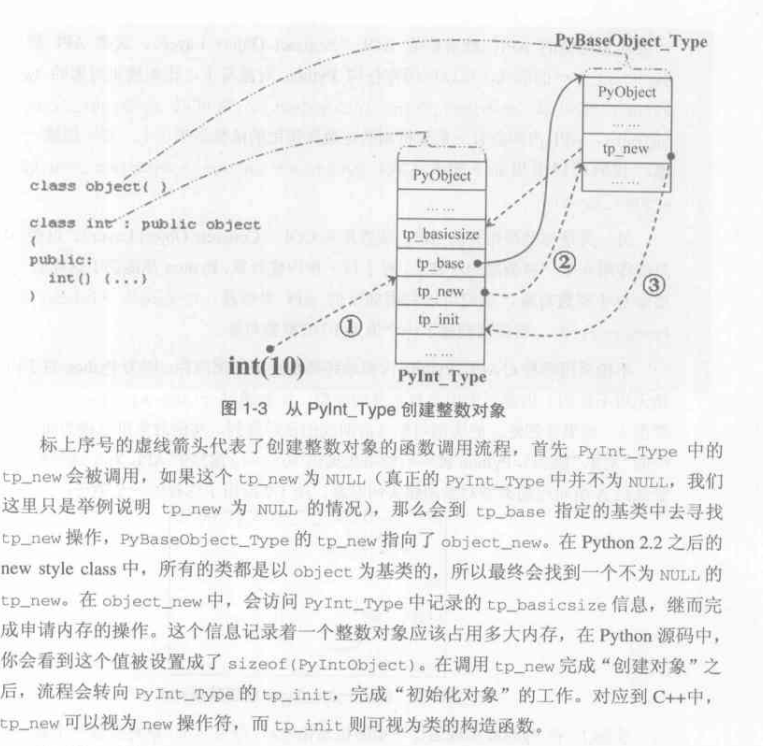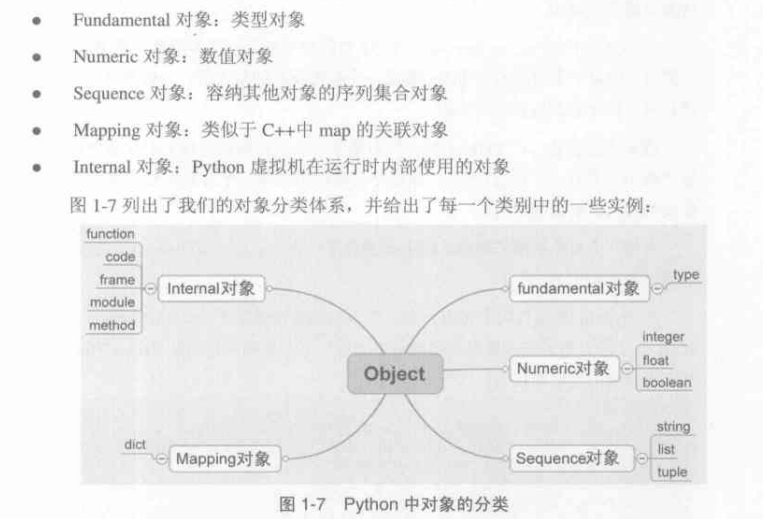1. 对象机制的基石 -- PyObject
a.PyOject 定义
[object.h]
typedef struct _object{
int ob_refcnt; //引用计数
struct _typeobject *ob_type; //类型信息
} PyObject
每一个python对象除了PyObject这部分必要信息,还有其他,比如PyIntObject
[intobject.h]
typedef struct{
PyObject_HEAD
long ob_ival; //整数的值
} PyIntObject;
b.定长对象和变长对象
如何实现字符串?
[object.h]
#define PyObject_VAR_HEAD
PyObject_HEAD
int ob_size; /*Number of items in variable part*/
typedef struct{
PyObject_VAR_HEAD
} PyVarObject;
c.类型对象
类型对象 _typeobject
其中主要包含四类信息
类型名 tp_name
创建该类型对象时分配的内存空间大小的信息 tp_basicsize和tp_itemsize
与该类型对象相关联的操作信息
其他类型信息
[object.h]
typedef struct _typeobject {
PyObject_VAR_HEAD
char *tp_name; /* For printing, in format "<module>.<name>" */
int tp_basicsize,tp_itemsize; /* For allocation */
/* Methods to implement standard operations */
destructor tp_dealloc;
printfunc tp_print;
......
/* More standard operations (here for binary compatibility) */
hashfunc tp_hash;
ternaryfunc to_call;
......
}
d.对象的创建
Python内部创建
通过Python C API
范型的API(AOL, Abstract Object Layer) 比如:PyObject* intObj = PyObject_New(PyObject, &PyInt_Type)
类型相关的API(COL, Concrete Object Layer) 比如: PyObject *intObj = PyInt_FromLong(10);
通过类型对象PyInt_Type

e.对象的行为
函数指针直接决定这一个对象在运行时所表现出的行为
比如
数值特性(PyNumberMethods *tp_as_number)
序列特性(PySequenceMethods *tp_as_sequence)
关联特性(PyMappingMethods *tp_as_mapping)
[object.h]
typedef PyObject *(*binaryfunc)(PyObject *, PyObject *);
typedef struct{
binaryfunc nb_add;
binaryfunc nb_subtract;
......
} PyNumberMethods;
特性的混合
class MyInt(int):
def __getitem__(self,key):
return key + str(self)
>> a = Myint(1)
>> b = Myint(2)
>> print a + b
3
>> a['key']
'key1'
f.类型的类型
PyType_Type =>
它是所有class的class,被称为metaclass
[typeobject.c]
PyTypeObject PyType_Type = {
PyObject_HEAD_INIT(&PyType_Type)
0, /* ob_size */
"type" /* tp_name */
sizeof(PyHeapTypeObject), /* tp_basicsize */
sizeof(PyMemberDef), /* tp_itemsize */
...
};
PyTypeObject和PyType_Type的关系
>> class A(object):
pass
>>A.__class__
<type 'type'>
>>int.__class__
<type 'type'>
>>type.__class__
<type 'type'>
举例
PyInt_Type和PyType_Type之间的关系
[intobject.c]
PyTypeObject PyInt_type = {
PyObject_HEAD_INIT(&PyType_Type)
0,
"int",
sizeof(PyIntObject),
...
}
运行时整数对象及其类型之间的关系

g.Python对象的多态性
通过ob_type域动态进行判断,Python实现了多态机制
void Print(PyObject *object){
object->ob_type->tp_print(object);
}
h.引用计数
ob_refcnt 变量,32位整型,决定着对象的创建与消亡
通过Py_INCREF(op) 和 PyDECREF(op) 两个宏来增加和减少一个对象的引用计数
通过_Py_NewReference(op)宏来将对象的引用计数初始化为1
PyDECREF 的“析构动作” 是通过一个函数指针tp_dealloc来进行的(Observer设计模式)
在Python的各种对象中, 类型对象永远不会被析构
[object.h]
#define _Py_NewReference(op) ((op)->ob_refcnt = 1)
#define _Py_Dealloc(op) ((*(op)->ob_type->tp_dealloc)((PyObject *)(op)))
#define Py_INCREF ((op)->ob_refcnt++)
#define Py_DECREF(op)
if(--(op)->ob_refcnt != 0);
else
_Py_Dealloc((PyObject *)(op))
/* Macros to use in case the object pointer may be NULL */
#define Py_XINCREF(op) if ((op) == NULL); else Py_INCREF(op)
#define Py_XDECREF(op) if ((op) == NULL); else Py_DECREF(op)
i.Python对象的分类
